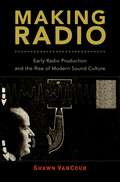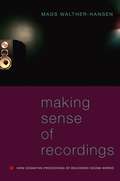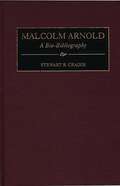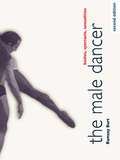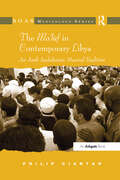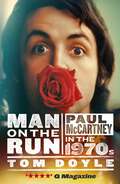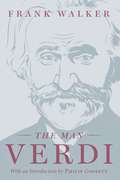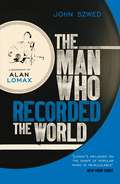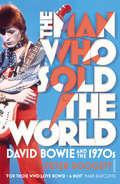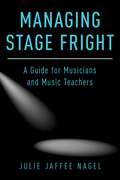- Table View
- List View
Making Radio: Early Radio Production and the Rise of Modern Sound Culture
by Shawn VanCourThe opening decades of the twentieth century witnessed a profound transformation in the history of modern sound media, with workers in U.S. film, radio, and record industries developing pioneering production methods and performance styles tailored to emerging technologies of electric sound reproduction that would redefine dominant forms and experiences of popular audio entertainment. Focusing on broadcasting's initial expansion during the 1920s, Making Radio explores the forms of creative labor pursued for the medium in the period prior to the better-known network era, assessing their role in shaping radio's identity and identifying affinities with parallel practices pursued for conversion-era film and phonography. Tracing programming forms adopted by early radio writers and programmers, production techniques developed by studio engineers, and performance styles cultivated by on-air talent, it shows how radio workers negotiated a series of broader industrial and cultural pressures to establish best practices for their medium that reshaped popular forms of music, drama, and public oratory and laid the foundation for a new era of electric sound entertainment.
Making Radio: Early Radio Production and the Rise of Modern Sound Culture
by Shawn VanCourThe opening decades of the twentieth century witnessed a profound transformation in the history of modern sound media, with workers in U.S. film, radio, and record industries developing pioneering production methods and performance styles tailored to emerging technologies of electric sound reproduction that would redefine dominant forms and experiences of popular audio entertainment. Focusing on broadcasting's initial expansion during the 1920s, Making Radio explores the forms of creative labor pursued for the medium in the period prior to the better-known network era, assessing their role in shaping radio's identity and identifying affinities with parallel practices pursued for conversion-era film and phonography. Tracing programming forms adopted by early radio writers and programmers, production techniques developed by studio engineers, and performance styles cultivated by on-air talent, it shows how radio workers negotiated a series of broader industrial and cultural pressures to establish best practices for their medium that reshaped popular forms of music, drama, and public oratory and laid the foundation for a new era of electric sound entertainment.
Making Sense of Recordings: How Cognitive Processing of Recorded Sound Works
by Mads Walther-HansenBuilding on ideas from cognitive metaphor theory, Making Sense of Recordings offers a new perspective on record production, music perception, and the aesthetics of recorded sound. It shows how the language about sound is intimately connected to sense-making - both as a reflection of our internal cognitive capacities and as a component of our extended cognitive system. In doing so, the book provides the foundation for a broader understanding of the history of listening, discourses of sound quality, and artistic practices in the age of recorded music. The book will be of interest to anyone who asks how recorded music sounds and why it sounds as it does, and it will be a valuable resource for musicology students and researchers interested in the analysis of sound and the history of listening and record production. Additionally, sound engineers and laptop musicians will benefit from the book's exploration of the connection between embodied experiences and our cognitively processed experiences of recorded sound. The tools provided will be useful to these and other musicians who wish to intuitively interact with recorded or synthesized sound in a manner that more closely resembles the way they think and that makes sense of what they do.
Making Time for Making Music: How to Bring Music into Your Busy Life
by Amy NathanAre you a former music-maker who yearns to return to music, but aren't sure where to begin? Or are you a person who never played music as a child but you are now curious about trying? You're not alone. Many adults who used to play an instrument haven't touched it in years because either they can't find the time to practice, are afraid their skills are too rusty, or are unsure of what kind of group they could join. Others are afraid to sing or start playing an instrument because they received negative feedback from childhood experiences. Performing, practicing, and composing music may seem like unattainable goals with insurmountable obstacles for busy adults with non-musical careers. Making Time for Making Music can help adults find ways to make music part of their lives. The first book of its kind, it is filled with real-life success stories from more than 350 adults who manage to fit music-making into their jam-packed schedules. They polished rusty skills, found musical groups to join, and are having a great time. Their testimonies prove that you are never too old to learn to make music, and that there are numerous musical paths to explore. Featuring advice from dozens of music educators, health care professionals, and music researchers who point out that making music can even be good for your health as well as an extensive resource list of websites, organizations, and summer programs, this book offers inspiration and tried-and-true strategies for anyone who wishes to return to music-making or begin as an adult.
MAKING TIME FOR MAKING MUSIC C: How to Bring Music into Your Busy Life
by Amy NathanAre you a former music-maker who yearns to return to music, but aren't sure where to begin? Or are you a person who never played music as a child but you are now curious about trying? You're not alone. Many adults who used to play an instrument haven't touched it in years because either they can't find the time to practice, are afraid their skills are too rusty, or are unsure of what kind of group they could join. Others are afraid to sing or start playing an instrument because they received negative feedback from childhood experiences. Performing, practicing, and composing music may seem like unattainable goals with insurmountable obstacles for busy adults with non-musical careers. Making Time for Making Music can help adults find ways to make music part of their lives. The first book of its kind, it is filled with real-life success stories from more than 350 adults who manage to fit music-making into their jam-packed schedules. They polished rusty skills, found musical groups to join, and are having a great time. Their testimonies prove that you are never too old to learn to make music, and that there are numerous musical paths to explore. Featuring advice from dozens of music educators, health care professionals, and music researchers who point out that making music can even be good for your health as well as an extensive resource list of websites, organizations, and summer programs, this book offers inspiration and tried-and-true strategies for anyone who wishes to return to music-making or begin as an adult.
Malcolm Arnold: A Bio-Bibliography (Bio-Bibliographies in Music)
by Stewart R. CraggsMalcolm Arnold's music encompassed a variety of forms from opera and ballet through orchestral and chamber music to film scores. His most famous film score, for which he won an Oscar award in 1957, is The Bridge on the River Kwai. In 1953 he was commissioned to compose Homage to the Queen, a ballet to celebrate the coronation of Queen Elizabeth II. Arnold was knighted by the Queen in 1993 in honor of his contributions to English music. As with the other volumes in the Greenwood Bio-Bibliographies in Music series, this work includes a brief biography, discography, complete list of works and performances, and an annotated bibliography.Music scholars, musicians, and those with an interest in the music of Malcolm Arnold will appreciate the extensive information gathered in this one volume. Since Malcolm Arnold has retired from composing, this book features the most complete list of his compositions, including some of his newly discovered early works. The works are listed alphabetically within genre. The author also provides a chronological listing of the works through which trends and developments in Arnold's compositions may be traced. Sir Malcolm Arnold's input with the project assures the accuracy and completeness of this bio-bibliography.
The Male Dancer: Bodies, Spectacle, Sexualities
by Ramsay BurtIn this challenging and lively book, Burt examines the representation of masculinity in twentieth century dance. The Male Dancer has proven to be essential reading for anyone interested in dance and the cultural construction of gender.
The Male Dancer: Bodies, Spectacle, Sexualities
by Ramsay BurtIn this challenging and lively book, Burt examines the representation of masculinity in twentieth century dance. The Male Dancer has proven to be essential reading for anyone interested in dance and the cultural construction of gender.
Mallarmé Wagner: Music and Poetic Language
by Heath LeesThis book challenges and replaces the existing view of Mallarm mission to 're-possess' music on behalf of poetic language. Traditionally, this view focused on only the last fifteen years of the poet's life, and sprang from a belief in Mallarm 'sudden awakening' to music during an all-Wagner concert in Paris, in 1885. Professor Heath Lees shows that Mallarm early knowledge and experience of music was much greater than commentators have realized, and that the French poet actually began his writing career with the explicit aim of making music's performance-language of 'effect' the ground of his poetic expression. Integral to the argument is Mallarm reaction to the work and ideas of Richard Wagner, whose impact on France came in two waves: the first broke during the tempestuous 1860s days of the Paris Tannhäuser, while the second arrived in the mid-1880s, and gave birth to the Revue Wagn enne. In refuting the critical literature that focuses on only the second of these waves, Lees shows that Mallarm xhibited a highly informed Wagnerian background during the first wave, and that his grasp of the composer's gestural motives and flexible musical prose led him towards a new kind of self-expressive, gestural rhythm that aimed musically to reinvent poetic language. In support of this, the book examines closely what Wagner 'really' said in the prose works that were becoming known in Paris by the 1860s, in particular, Wagner's important French text, the Lettre sur la musique. It also re-examines Baudelaire's classic Wagner-brochure, and reveals its author's surprisingly firm grasp of Wagner's musico-poetic fusion. In musically informed commentary, Professor Lees surveys the four decades of success and failure that resulted from Mallarm repeated attempts to draw out the musical gestures and resonances of words alone. In the process, he throws new light on many of Mallarm best-known texts, hitherto judged 'difficult' by those who have failed to
Mallarmé Wagner: Music and Poetic Language
by Heath LeesThis book challenges and replaces the existing view of Mallarm mission to 're-possess' music on behalf of poetic language. Traditionally, this view focused on only the last fifteen years of the poet's life, and sprang from a belief in Mallarm 'sudden awakening' to music during an all-Wagner concert in Paris, in 1885. Professor Heath Lees shows that Mallarm early knowledge and experience of music was much greater than commentators have realized, and that the French poet actually began his writing career with the explicit aim of making music's performance-language of 'effect' the ground of his poetic expression. Integral to the argument is Mallarm reaction to the work and ideas of Richard Wagner, whose impact on France came in two waves: the first broke during the tempestuous 1860s days of the Paris Tannhäuser, while the second arrived in the mid-1880s, and gave birth to the Revue Wagn enne. In refuting the critical literature that focuses on only the second of these waves, Lees shows that Mallarm xhibited a highly informed Wagnerian background during the first wave, and that his grasp of the composer's gestural motives and flexible musical prose led him towards a new kind of self-expressive, gestural rhythm that aimed musically to reinvent poetic language. In support of this, the book examines closely what Wagner 'really' said in the prose works that were becoming known in Paris by the 1860s, in particular, Wagner's important French text, the Lettre sur la musique. It also re-examines Baudelaire's classic Wagner-brochure, and reveals its author's surprisingly firm grasp of Wagner's musico-poetic fusion. In musically informed commentary, Professor Lees surveys the four decades of success and failure that resulted from Mallarm repeated attempts to draw out the musical gestures and resonances of words alone. In the process, he throws new light on many of Mallarm best-known texts, hitherto judged 'difficult' by those who have failed to
The Malmariée in the Thirteenth-Century Motet (Royal Musical Association Monographs)
by Dolores PesceThis monograph offers a comprehensive study of the topos of the malmariée or the unhappily married woman within the thirteenth-century motet repertory, a vocal genre characterized by several different texts sounding simultaneously over a foundational Latin chant. Part I examines the malmariée motets from three vantage points: (1) in light of contemporaneous canonist views on marriage; (2) to what degree the French malmariée texts in the upper voices treat the messages inherent in the underlying Latin chant through parody and/or allegory; and (3) interactions among upper-voice texts that invite additional interpretations focused on gender issues. Part II investigates the transmission profile of the motets, as well as of their refrains, revealing not only intertextual refrain usage between the motets and other genres, but also a significant number of shared refrains between malmariée motets and other motets. Part II furthermore offers insights on the chronology of composition within a given intertextual refrain nexus, and examines how a refrain’s meaning can change in a new context. Finally, based on the transmission profile, Part II argues for a lively interest in the topos in the 1270s and 1280s, both through composition of new motets and compilation of earlier ones, with Paris and Arras playing a prominent role.
The Malmariée in the Thirteenth-Century Motet (Royal Musical Association Monographs)
by Dolores PesceThis monograph offers a comprehensive study of the topos of the malmariée or the unhappily married woman within the thirteenth-century motet repertory, a vocal genre characterized by several different texts sounding simultaneously over a foundational Latin chant. Part I examines the malmariée motets from three vantage points: (1) in light of contemporaneous canonist views on marriage; (2) to what degree the French malmariée texts in the upper voices treat the messages inherent in the underlying Latin chant through parody and/or allegory; and (3) interactions among upper-voice texts that invite additional interpretations focused on gender issues. Part II investigates the transmission profile of the motets, as well as of their refrains, revealing not only intertextual refrain usage between the motets and other genres, but also a significant number of shared refrains between malmariée motets and other motets. Part II furthermore offers insights on the chronology of composition within a given intertextual refrain nexus, and examines how a refrain’s meaning can change in a new context. Finally, based on the transmission profile, Part II argues for a lively interest in the topos in the 1270s and 1280s, both through composition of new motets and compilation of earlier ones, with Paris and Arras playing a prominent role.
The Ma'luf in Contemporary Libya: An Arab Andalusian Musical Tradition (SOAS Studies in Music)
by Philip CiantarThe musical tradition of Ma'luf is believed to have come to North Africa with Muslim and Jewish refugees escaping the Christian reconquista of Spain between the tenth and seventeenth centuries. Although this Arab Andalusian music tradition has been studied in other parts of the region, until now, the Libyan version has not received Western scholarly attention. This book investigates the place of this orally-transmitted music tradition in contemporary Libyan life and culture. It investigates the people that make it and the institutions that nurture it as much as the tradition itself. Patronage, music making, discourse both about life and music, history, and ideology all unite in a music tradition which looks innocent from the outside but appears quite intriguing and intricate the more one explores it.
The Ma'luf in Contemporary Libya: An Arab Andalusian Musical Tradition (SOAS Studies in Music)
by Philip CiantarThe musical tradition of Ma'luf is believed to have come to North Africa with Muslim and Jewish refugees escaping the Christian reconquista of Spain between the tenth and seventeenth centuries. Although this Arab Andalusian music tradition has been studied in other parts of the region, until now, the Libyan version has not received Western scholarly attention. This book investigates the place of this orally-transmitted music tradition in contemporary Libyan life and culture. It investigates the people that make it and the institutions that nurture it as much as the tradition itself. Patronage, music making, discourse both about life and music, history, and ideology all unite in a music tradition which looks innocent from the outside but appears quite intriguing and intricate the more one explores it.
The Mammoth Book of Sex, Drugs & Rock 'n' Roll (Mammoth Books)
by Jim DriverOver 60 gripping accounts tracking the dark side of rock 'n' roll from the early days of the drugs-and-drink culture, and the birth of rock 'n' roll, through The Beatles, Stones, Sex Pistols, Madonna, Kurt Cobain and Oasis, to Amy Winehouse, Pete Doherty and other stars of the current rock-music scene.From trashed hotel rooms to cars in swimming pools, all rock 'n' roll's excesses are here, including murder and sexual deviancy, surprising brushes with the law that the stars thought they'd kept quiet, early and tragic deaths, drug overdoses, robbery, mis-marriages and groupies by the truckload
Man on the Run: Paul McCartney in the 1970s
by Tom DoyleThe most famous living rock musician on the planet, Paul McCartney is now regarded as a slightly cosy figure, an (inter)national treasure. Back in the 1970s, however, McCartney cut a very different figure. He was, literally, a man on the run. Desperately trying to escape the shadow of the Beatles, he became an outlaw hippy millionaire, hiding out on his Scottish farmhouse in Kintyre before travelling the world with makeshift bands and barefoot children. It was a time of numerous drug busts and brilliant, banned and occasionally baffling records. For McCartney, it was an edgy, liberating and sometimes frightening period of his life that has largely been forgotten. Man on the Run paints an illuminating picture: from McCartney's nervous breakdown following the Beatles' split through his apparent victimisation by the authorities to the rude awakening of his imprisonment for marijuana possession in Japan in 1980 and the shocking wake-up call of John Lennon's murder. Ultimately, it poses the question: if you were one quarter of the Beatles, could you really outrun your past?
"Man töte dieses Weib": Weiblichkeit und Tod in der Musik der Jahrhundertwende
by Melanie UnseldDer Tod der schönen jungen Frauen - faszinierend für viele Komponisten, zelebriert in der Musik der Jahrhundertwende. Das Doppelmotiv von Tod und Weiblichkeit taucht in einer enormen Vielfalt und Vielzahl in der Musik zwischen Romantik und Moderne auf. Melanie Unseld breitet in ihrem Buch, quer durch die ästhetischen Schulen, ein umfassendes Spektrum aus. Unter anderem im Blickpunkt: Debussys und Schönbergs Mélisande, Zemlinskys und Dvoraks Seejungfrau, Puccinis Turandot und Strauss' Salome sowie Bergs Lulu.
The Man Verdi
by Frank WalkerIn this classic biography of composer Giuseppe Verdi, Frank Walker reveals Verdi the man through his connections with the individuals who knew him best. “Walker focuses on some of the more significant people in Verdi’s life and carefully scrutinizes his relationships with them. His wife, Giuseppina Strepponi; his student and amanuensis, Emanuele Muzio; the conductor who first fully understood Verdi’s mature art, Angelo Mariani; the great prima donna, Teresa Stolz; the incomparable librettist and friend of his old age, Arrigo Boito—each passes before our eyes in Walker’s meticulous reconstruction. As we learn more about them, we learn more about Verdi. We see him through the eyes of his closest friends, we watch his daily activities, his daily thoughts, his habits, his warmth, his domestic tyranny. The myth dissolves and a human being stands before us.”—Philip Gossett, from the introduction
The Man Who Recorded the World: A Biography of Alan Lomax
by John SzwedWriter, musicologist, archivist, singer, DJ, filmmaker, record, radio and TV producer, Alan Lomax was a man of many parts. Without him the history of popular music would have been very different. Armed with a tape-recorder and his own near-flawless good taste, Lomax spent years travelling the US, particularly the south, recording its heritage of music and song for posterity, bringing to light the talents of performers ranging from Jelly Roll Morton to Leadbelly and Muddy Waters, and crucially influencing generations of musicians from Pete Seeger to the Stones, from Woody Guthrie to Bob Dylan. His influence continues: recordings made by Lomax are the core of the sound-tracks of Oh Brother, Where art Thou? and Gangs of New York, and even featured, remixed, on Moby's Play. John Szwed's biography is the first ever of this remarkable and contradictory man (whom he both knew and worked with for ten years); through it Szwed will tell the story of a musical and political era, as he did so successfully in his previous book on Miles Davis.
The Man Who Sold The World: David Bowie And The 1970s
by Peter DoggettNo artist offered a more incisive and accurate portrait of the troubled landscape of the 1970s than David Bowie. Cultural historian Peter Doggett explores the rich heritage of Bowie's most productive and inspired decade, and traces the way in which his music reflected and influenced the world around him. From 'Space Oddity', his dark vision of mankind's voyage into the unknown terrain of space, to the Scary Monsters album, Doggett examines in detail Bowie's audacious creation of an 'alien' rock star, Ziggy Stardust, and his increasingly perilous explorations of the nature of identity and the meaning of fame.Mixing brilliant musical critique with biographical insight and acute cultural analysis, The Man Who Sold The World is a unique study of a major artist and his times.
Managing Stage Fright: A Guide for Musicians and Music Teachers
by Julie Jaffee NagelWhy is it that well-prepared, talented, hardworking, and intelligent performers find their performance and self-esteem undermined by the fear of memory slips, technique failures, and public humiliation? In Managing Stage Fright: A Guide for Musicians and Music Teachers, author Julie Jaffee Nagel unravels these mysteries, taking the reader on an intensive backstage tour of the anxious performer's emotions to explain why stage fright happens and what performers can do to increase their comfort in the glare of the spotlight. Examining the topic from her interdisciplinary educational, theoretical, clinical, and personal perspectives, Nagel uses the music teacher/student relationship as a model for understanding the performance anxiety that affects musicians and non-musicians alike. Shedding new light on how the performer's emotional life is connected to every other facet of their life, Managing Stage Fright encourages a deeper understanding of anxiety when performing. The guide offers strategies for achieving performance confidence, emphasizing the relevance of mental health in teaching and performing. Through the practices of self-awareness outlined in the book, Nagel demonstrates that it is possible and desirable for teachers to assist students in developing the coping skills and attitudes that will allow them to not feel overwhelmed and powerless when they experience strong anxiety. Each chapter contains insights that help teachers recognize the symptoms-obvious, subtle, and puzzling-of the emotional grip of stage fright, while offering practical guidelines that empower teachers to empower their students. The psychological concepts offered, when added to pedagogical techniques, are invaluable in music performance and in a variety of life situations since, after all, music lessons are life lessons.
MANAGING STAGE FRIGHT C: A Guide for Musicians and Music Teachers
by Julie Jaffee NagelWhy is it that well-prepared, talented, hardworking, and intelligent performers find their performance and self-esteem undermined by the fear of memory slips, technique failures, and public humiliation? In Managing Stage Fright: A Guide for Musicians and Music Teachers, author Julie Jaffee Nagel unravels these mysteries, taking the reader on an intensive backstage tour of the anxious performer's emotions to explain why stage fright happens and what performers can do to increase their comfort in the glare of the spotlight. Examining the topic from her interdisciplinary educational, theoretical, clinical, and personal perspectives, Nagel uses the music teacher/student relationship as a model for understanding the performance anxiety that affects musicians and non-musicians alike. Shedding new light on how the performer's emotional life is connected to every other facet of their life, Managing Stage Fright encourages a deeper understanding of anxiety when performing. The guide offers strategies for achieving performance confidence, emphasizing the relevance of mental health in teaching and performing. Through the practices of self-awareness outlined in the book, Nagel demonstrates that it is possible and desirable for teachers to assist students in developing the coping skills and attitudes that will allow them to not feel overwhelmed and powerless when they experience strong anxiety. Each chapter contains insights that help teachers recognize the symptoms-obvious, subtle, and puzzling-of the emotional grip of stage fright, while offering practical guidelines that empower teachers to empower their students. The psychological concepts offered, when added to pedagogical techniques, are invaluable in music performance and in a variety of life situations since, after all, music lessons are life lessons.
Manchester Beethoven studies
by Barry Cooper Matthew PilcherManchester Beethoven studies presents ten original chapters by scholars with close ties to the University of Manchester. It throws new light on many aspects of Beethoven’s life and works, with a special emphasis on early or little-known compositions such as his concert aria Erste Liebe, his String Quintet Op. 104 and his folksong settings. Biographical elements are prominent in a wide-ranging reassessment of his religious attitudes and beliefs, while Charles Hallé, founder of the Manchester-based Hallé Orchestra, is revealed to have been a tireless and energetic promoter of Beethoven’s music in the later nineteenth century.
Manchester Beethoven studies
by Barry Cooper Matthew PilcherManchester Beethoven studies presents ten original chapters by scholars with close ties to the University of Manchester. It throws new light on many aspects of Beethoven’s life and works, with a special emphasis on early or little-known compositions such as his concert aria Erste Liebe, his String Quintet Op. 104 and his folksong settings. Biographical elements are prominent in a wide-ranging reassessment of his religious attitudes and beliefs, while Charles Hallé, founder of the Manchester-based Hallé Orchestra, is revealed to have been a tireless and energetic promoter of Beethoven’s music in the later nineteenth century.
Manchester Cathedral: A history of the Collegiate Church and Cathedral, 1421 to the present
by Jeremy GregoryFounded in 1421, the Collegiate Church of Manchester, which became a cathedral in 1847, is of outstanding historical and architectural importance. But until now it has not been the subject of a comprehensive study. Appearing on the 600th anniversary of the Cathedral’s inception by Henry V, this book explores the building’s past and its place at the heart of the world's first industrial city, touching on everything from architecture and music to misericords and stained glass. Written by a team of renowned experts and beautifully illustrated with more than 100 photographs, this history of the ‘Collegiate Church’ is at the same time a history of the English church in miniature.
